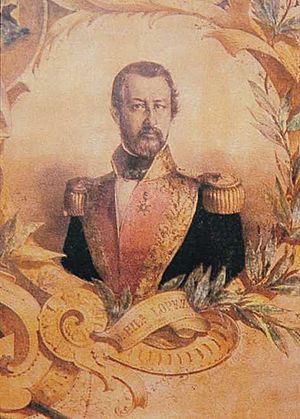José Hilario López facts for kids
Quick facts for kids
José Hilario López
|
|
|---|---|
 |
|
| 5th President of the Republic of the New Granada | |
| In office 1 April 1849 – 1 April 1853 |
|
| Preceded by | Tomás Cipriano de Mosquera |
| Succeeded by | José María Obando |
| Personal details | |
| Born | February 18, 1798 Popayán, Cauca |
| Died | November 27, 1869 (aged 71) Campoalegre, Campoalegre, Huila |
| Political party | Liberal |
| Spouse | María Dorotea Durán Borrero |
José Hilario López Valdés (born February 18, 1798, in Popayán, Cauca; died November 27, 1869, in Campoalegre, Huila) was an important Colombian politician and army officer. He served as the President of Colombia from 1849 to 1853.
Contents
Early Life and Education
José Hilario López was the son of José Casimiro López and Rafaela Valdés y Fernández. He grew up in Popayán. He went to school at the seminary there. His teacher was a well-known scholar named José Félix de Restrepo. When José Hilario was 14 years old, he stopped his studies. He decided to join the army that was fighting for independence.
Joining the Army and Early Battles
At just 14, López became a cadet in the revolutionary army. He fought in several battles, including Alto Palacé (December 1813) and Calibío (January 1814). He also took part in the battles of Tacines (May 1814) and Pasto (May 1813). During the battle of La Cuchilla del Tambo, López was captured by the Spanish army.
He was sent to Bogotá and faced a military trial. He was found guilty of treason against the Spanish Crown. His death sentence was changed. Instead, he had to serve in the royal army. He was forced to do hard labor and even execute rebel leaders. On July 24, 1819, he was finally pardoned and set free. This happened after his aunt, Eusebia Caicedo, helped him.
Fighting for Independence
In 1820, López met General Simón Bolívar, a famous leader of the independence movement. Bolívar made him a lieutenant in a new army group called the "Boyacá Battalion." López helped free a friend he had met in prison. He was promoted to lieutenant mayor and then to captain.
He fought in the "Northern Campaign" in what is now Venezuela. After this campaign ended in 1823, López returned to Bogotá. General Francisco de Paula Santander appointed him as the military chief of the Cauca province. In April 1823, he was promoted to lieutenant colonel.
Later Military and Political Roles
After a plot against General Simón Bolívar in 1828, López rebelled. He joined forces with Colonel José María Obando. They fought against Bolívar's government.
Soon after, a war broke out between Gran Colombia and Peru. Bolívar made an agreement with the rebel commanders. He pardoned them in March 1829. Bolívar also explained why he had changed some rules, especially after General José Antonio Páez's actions in Venezuela.
Becoming a Political Leader
In September 1830, López and Obando rebelled again. They aimed to weaken the government of Rafael Urdaneta. Their forces took control of much of the south, including Popayán. López advanced to Tocaima, where he met General Rafael Urdaneta. They agreed to a ceasefire, signing the "Apulo Agreement" in April 1831.
The next year, under the government of Francisco de Paula Santander, López became military chief of Bogotá. In 1834, he was made governor of Cartagena. López also held other important jobs. He was Secretary of War and Navy, and Colombia's Ambassador to the Papal States. He also served as Secretary of Foreign Relations, a state advisor, and a senator.
President of Colombia: Major Changes
On March 7, 1849, José Hilario López was elected President of Colombia. He had strong support from workers and their democratic clubs. He also benefited from disagreements among conservative groups. His time as president brought many big changes to Colombia.
Ending Slavery and Land Reforms
One of his most important actions was to end slavery in Colombia. This was a huge step forward for human rights. His government also created a new agrarian law. This law changed how land was owned and used.
Separation of Church and State
López also supported the idea of separating the church and the government. This meant that the government would not control religious matters, and the church would not control government decisions. He also promoted freedom of the press, allowing people to express their opinions more freely.
Challenges and Conflicts
Ending slavery caused some resistance. Some conservative groups in the Cauca region rebelled, led by Julio Arboleda. However, López's government forces quickly stopped this uprising. In Cali, there were conflicts between landowners and common people.
López's government also allowed the sale of Resguardos. These were lands set aside for Amerindian communities. This decision went against the wishes of some of his supporters. It allowed wealthy people to benefit from new workers who sought jobs on tobacco farms.
Later Years and Retirement
A year after his presidency ended in 1853, López joined forces with both conservative and liberal armies. They worked together to remove General José Maria Melo from the presidency during the “Artisans Revolution” of 1854.
During the civil war of 1859, López joined the "radical liberals." They supported the idea of a federation, where states would have more power. López was elected President of Tolima in July 1863. In 1865, he ran to lead the Colombian Union but lost to President Tomas Cipriano de Mosquera.
In 1867, President Mosquera closed the National Congress. Because of this, he was removed from office. López was then named Army Chief by the new temporary government of Santos Acosta. After these events, he decided to retire from politics. He returned to his farms and lived there until his death.
Images for kids
See also
 In Spanish: José Hilario López para niños
In Spanish: José Hilario López para niños




